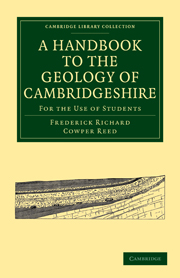INTRODUCTION
Published online by Cambridge University Press: 05 July 2011
Summary
The Cambridgeshire area is full of interest to the geologist not only on account of the variety of the strata which range from the Oxford Clay to recent fluviatile deposits, but also because of the peculiar local development and relations of some of the formations. We may mention for instance the argillaceous representative of the Corallian limestones of other districts, the Upware coral reef, the Cambridge Greensand, and the river-terraces.
Physical features. There are four natural regions depending on geological structure into which the County of Cambridgeshire may be divided. These are (1) the chalk hills and plateau in the south and east; (2) the high ground in the west; (3) the median valley of the Rhee, and the Cam, and (4) the Fenland in the north. There is no definite line of demarcation between the last two regions, for the river-valley widens out gradually and passes imperceptibly into the Fenland.
The first region comprises the whole range of chalk hills from Royston in the south-west to Newmarket in the north-east, and from it flow down the main tributaries of the Cam and Ouse, cutting their way through the face of the escarpment. In many parts the typical scenery of a chalk country is displayed, as for instance round Royston, where the well-known rolling outlines of chalk downs covered with short smooth turf present a marked contrast to the level plain in the northern part of the county.
- Type
- Chapter
- Information
- A Handbook to the Geology of CambridgeshireFor the Use of Students, pp. 1 - 7Publisher: Cambridge University PressPrint publication year: 2009First published in: 1897



